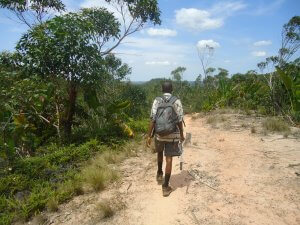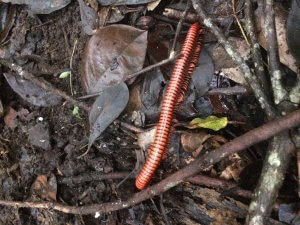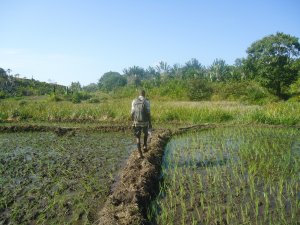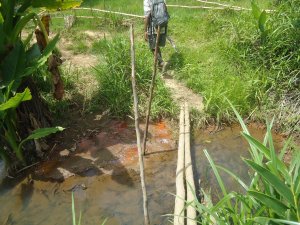My time in Madagascar has been sandwiched between the end of the dry season and the beginning of the rainy season. And indeed, the first five weeks of my adventures here in Madagascar were very hot and dry. Whenever I was exposed to the sun, whether hiking through deforested mountainsides or walking to the market, the repetitive chorus of a popul ar Malagasy tropical song ran through my mind: Mafana Mafana Mafana. Hot Hot Hot. The blistering temperatures signified the final weeks of the dry season, a window of time in which many Malagasy use for tavy (slash and burn). The dry trees and underbrush of the forest can easily be coaxed into lighting up in flames. As rainforests are naturally wet and rainy, it has taken many years and unbelievable deforestation to change the entire biosphere into one that is conducive for burning. It is not a pleasant thought to dwell upon.
ar Malagasy tropical song ran through my mind: Mafana Mafana Mafana. Hot Hot Hot. The blistering temperatures signified the final weeks of the dry season, a window of time in which many Malagasy use for tavy (slash and burn). The dry trees and underbrush of the forest can easily be coaxed into lighting up in flames. As rainforests are naturally wet and rainy, it has taken many years and unbelievable deforestation to change the entire biosphere into one that is conducive for burning. It is not a pleasant thought to dwell upon.
But, this year the rainy season started early. These last two two weeks have brought endless downpours, showers, sprinkles, and drizzles. The forest is happy, and much safer than is typical in November. The rain smothers the fires from tavy and draws out the fire millipedes. The foot-long arthropods, wanting to avoid the flooded/saturated forest floor, crawl from unknown hiding places and into the trees. Their numerous bright legs seek dry branches in vain and mesmerize us with their fluid movements. Purples, reds, and oranges, their hues of their legs are taken from the same palette as sunsets.
November. The rain smothers the fires from tavy and draws out the fire millipedes. The foot-long arthropods, wanting to avoid the flooded/saturated forest floor, crawl from unknown hiding places and into the trees. Their numerous bright legs seek dry branches in vain and mesmerize us with their fluid movements. Purples, reds, and oranges, their hues of their legs are taken from the same palette as sunsets.
I am still of two minds about whether I prefer the dry or rainy season better. Regardless of season, I am wet, either from perspiration or from rain. But at least in the rainy season, the forest is safe from fire. For humans however, the rain makes hiking through the forests much more difficult. We slip, we slide, and we fall whether we are going uphill or downhill. Last Monday in Vatovavy, I endured a particularly arduous day. It had been surprisingly sunny for a couple days during the weekend, but started pouring on Sunday night, continuing all night and into the following day. I was to follow a lemur that was markedly far away, so Edgard (my guide) and I set off at a brisk pace that morning.
The narrow paths had transformed into small  creeks and our hiking shoes were soon soaked through and covered in mud. About half an hour into the hike, we came to the fields of rice paddies that stand between the tiny communities on the hillsides and the forest fragment that lays behind it. (pictured are the rice paddies during the dry season) I heard my guide say “uh oh” as he arrived at the bridge connecting the path with the dikes of the rice paddies. I rounded the corner and saw the reason for his dismay. The “bridge” (two small pieces of warped wood) was nowhere to be seen, under at least a foot of water from the turgid creek. And the “railings” (two tall sticks stuck vertically into the bed of the creek) were swaying with the current and too far to reach from land. (pictured is the bridge when during the dry season) Edgard hesitantly put one foot into the water, finding the makeshift bridge, and successfully inched his way across. It was my turn. All the warnings about avoiding contact with the rivers and waters flashed through my mind. But I had no choice; it was much too far to jump. I stepped into the dark water, finding the bridge, and made my way across. Little did I know, the bridge was the least of my worries. We began traversing through the dikes of the rice
creeks and our hiking shoes were soon soaked through and covered in mud. About half an hour into the hike, we came to the fields of rice paddies that stand between the tiny communities on the hillsides and the forest fragment that lays behind it. (pictured are the rice paddies during the dry season) I heard my guide say “uh oh” as he arrived at the bridge connecting the path with the dikes of the rice paddies. I rounded the corner and saw the reason for his dismay. The “bridge” (two small pieces of warped wood) was nowhere to be seen, under at least a foot of water from the turgid creek. And the “railings” (two tall sticks stuck vertically into the bed of the creek) were swaying with the current and too far to reach from land. (pictured is the bridge when during the dry season) Edgard hesitantly put one foot into the water, finding the makeshift bridge, and successfully inched his way across. It was my turn. All the warnings about avoiding contact with the rivers and waters flashed through my mind. But I had no choice; it was much too far to jump. I stepped into the dark water, finding the bridge, and made my way across. Little did I know, the bridge was the least of my worries. We began traversing through the dikes of the rice  paddies. The fields are shaped to hold water, and even during the dry season traversing the paddies was treacherous and required small makeshift bridges to avoid swampy areas. In one such place, a couple pieces of wood lay several inches submerged under water from the flooding. The wood only stretched a couple feet, and I eyed the ground where the bridge ended. “I can make that”, I thought, thinking I would cleverly avoid soaking my shoes once more. Suddenly, one of my legs was knee deep in swampy waters. My jump had resulted in one leg on solid ground, and one engulfed by a rice paddy. I pulled my leg out with a squelching noise, the mud having formed a suction around my leg as if it was reluctant to let go. I scrambled to my feet again, trying to regain my dignity as Edgard glanced back and saw me sprawled on the ground, one leg disappeared into a rice paddy. After assuring him I was okay, we set off again to finish our hour and a half hike to find FIG, our focal lemur for the day.
paddies. The fields are shaped to hold water, and even during the dry season traversing the paddies was treacherous and required small makeshift bridges to avoid swampy areas. In one such place, a couple pieces of wood lay several inches submerged under water from the flooding. The wood only stretched a couple feet, and I eyed the ground where the bridge ended. “I can make that”, I thought, thinking I would cleverly avoid soaking my shoes once more. Suddenly, one of my legs was knee deep in swampy waters. My jump had resulted in one leg on solid ground, and one engulfed by a rice paddy. I pulled my leg out with a squelching noise, the mud having formed a suction around my leg as if it was reluctant to let go. I scrambled to my feet again, trying to regain my dignity as Edgard glanced back and saw me sprawled on the ground, one leg disappeared into a rice paddy. After assuring him I was okay, we set off again to finish our hour and a half hike to find FIG, our focal lemur for the day.
I had somehow convinced myself while in the forest that the way back through the rice paddies and bridge would not be quite as unseemly. But alas, I was sorely mistaken. The way back resulted in going stomach down in the rice paddies, this time, my arm going elbow deep into the muddy waters. And the creek had fully claimed the bridge as its own, the water flowing at least a foot above the planks, and the muddy banks causing Edgard and I both to slip and fall while exiting the water.
I was soaked to the bone when I returned to the field station, and after drying myself, retreated to my tent for the dry, warm comfort of my sleeping bag. But thankfully, after a few hours, I was able to laugh about my misfortune when sharing my adventures with the other volunteers at dinner. Because really, how bad could it be, when I’m tracking lemurs in Madagascar.

